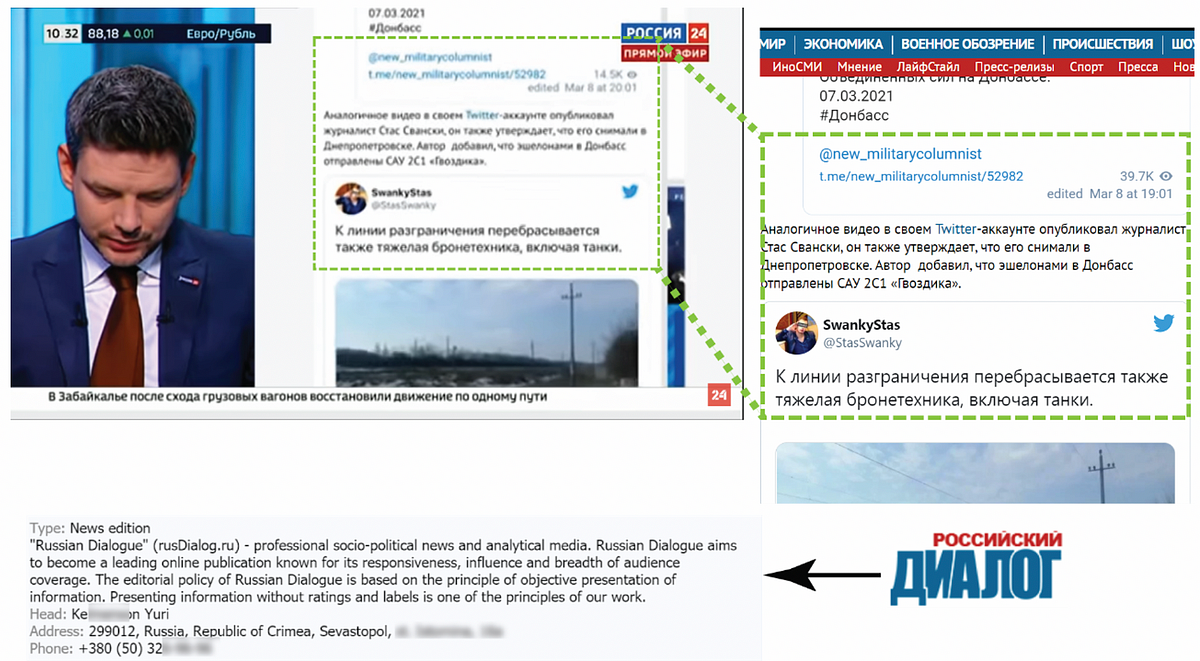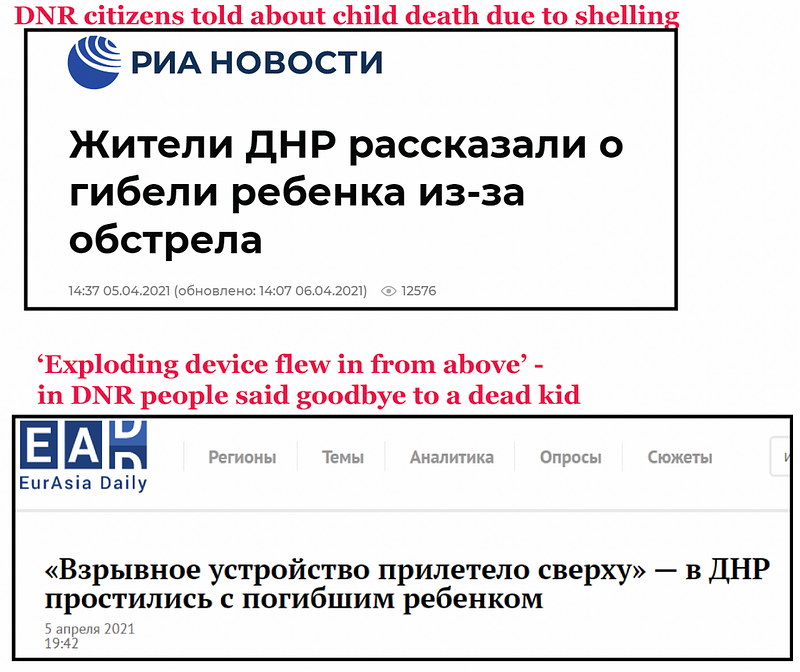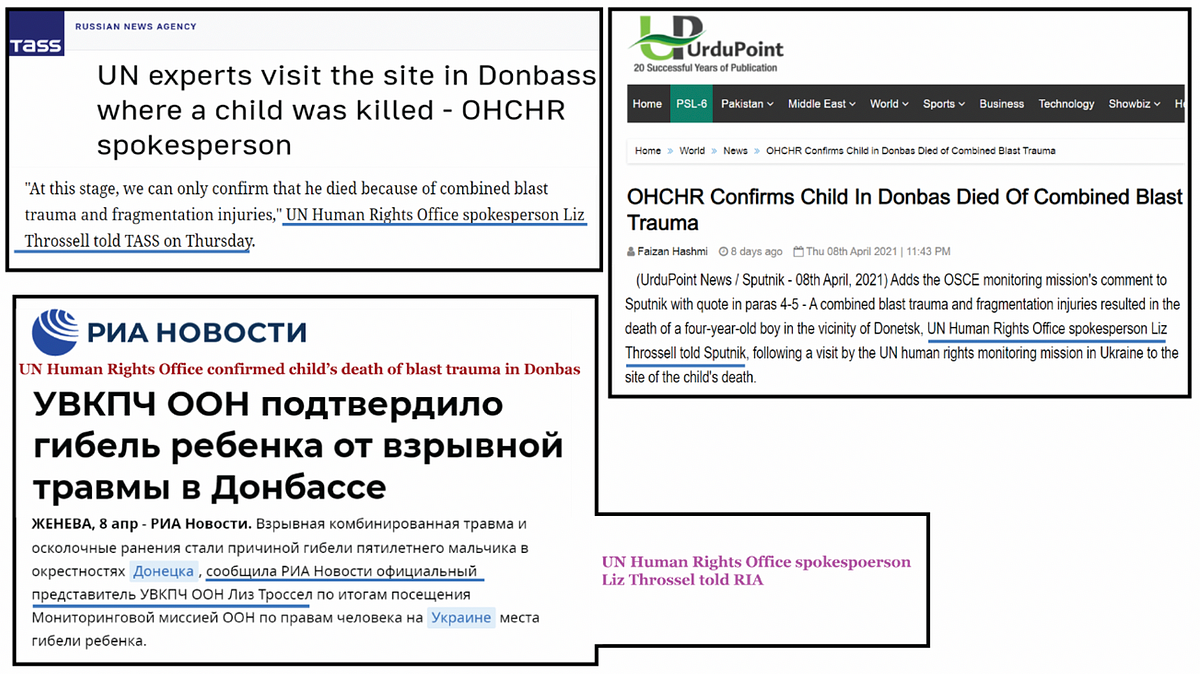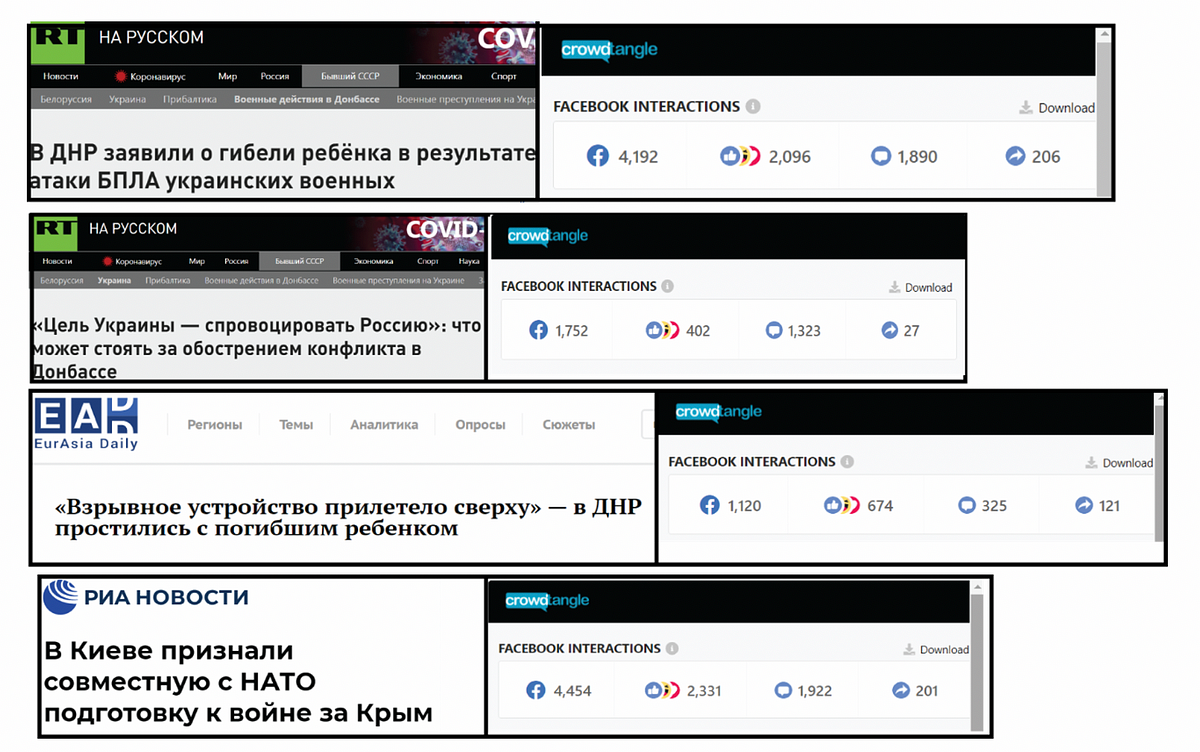To justify Russian force buildup, pro-Kremlin media and actors amplified multiple narratives blaming Ukraine for the conflict

By Roman Osadchuk
Pro-Kremlin actors launched a multi-faceted information campaign to blame Ukraine in the recent escalation of the conflict with Russia and pro-Kremlin proxies in Donbas, including the heavy buildup of Russian forces near Ukrainian borders. The narratives spread across different platforms targeting multiple audiences, ranging from Russian citizens to foreign observers.
The information campaign accompanied the deterioration of the ceasefire in Donbas, as Russian forces started a buildup in Voronezh and occupied Crimea, close to the Ukrainian border. Previously, in 2014, Russia also used disinformation campaigns to justify the annexation of the peninsula and military support for the so-called people’s republics.
The DFRLab investigated two narratives in particular. The first argued that Ukraine was planning to gain the occupied territories back through the use of force. Despite escalating violations of the ceasefire, however, Ukraine never terminated the ceasefire agreement and stressed a defensive posture. The second narrative claimed that a Ukrainian UAV was responsible for killing a child in an explosion in the occupied village of Oleksandrivske. While the boy’s death was indeed confirmed by the OSCE, the actual cause of the explosion was unknown, and there was no evidence of UAV involvement.
The spread of these narratives among pro-Kremlin sources illustrated the cross-platform nature of the pro-Kremlin disinformation ecosystem, as the content jumped across VK, Telegram, Twitter, Facebook, fringe (as recently reported by the DFRLab), and mainstream Russian media.
Arguing the Russian buildup is a preventative measure
On February 21, 2021, the Russian Ministry of Defense announced an airborne troops exercise in Crimea, raising alarm over Russian intentions. Around the same time, in reaction to recent Ukrainian sanctions against pro-Kremlin TV channels, the Russian presidential press secretary Dmitry Peskov questioned Ukraine’s intentions regarding the conflict in eastern Ukraine. Peskov suggested that Ukraine’s decision to sanction pro-Kremlin media could further embolden Ukrainian authorities to “solve the situation in the southeast with military means.” Soon after, an OSCE report on March 8 stated that monitors observed the Armed Forces of Ukraine moved military equipment outside of the designated storage sites, but beyond the lines of withdrawal. OSCE monitors these movements, which are fairly routine, consistently from both sides of the front line. In Ukraine, the report was presented by pro-Kremlin outlet Strana.UA, which has a record of lax journalistic standards, as out of the ordinary.
The most prevalent narrative on social media reversed the sequence of events. It portrayed Ukraine as an aggressor that wants to initiate a full-scale war so that Russia would be forced to help Donbas. On March 9, the Kremlin-owned TV channel Russia 24 published two videos on its YouTube channels suggesting that Ukraine was ready for a “power scenario,” meaning full-scale fighting in Donbas.
Soon after, multiple videos appeared on social media that showed the transportation of armored vehicles. These videos got picked up by fringe media outlets registered in occupied Crimea, such as Russian Dialog and TV channel Russia 24. The latter also provided the airtime to Denis Pushilin, the head of the so-called Donetsk People’s Republic (DNR in Russian), who blamed Ukraine for the escalation. A few days later, the Russian Foreign Ministry warned Ukraine against attempts to seize back Donbas by force.

The Kremlin-owned channel ORT tried to promote the narrative further in a talk show. The story received the most attention around March 29, when Russia started moving military equipment to the Ukrainian border on a scale not seen since 2014–2015.
Kremlin-owned outlet Ukraina.ru published an opinion piece arguing that Russia should recognize the “republics” so that the attack Ukraine was allegedly planning would be against Russian territories, which would in turn justify a military response from Russia. Pro-Kremlin outlet Moscow Komsomolets published the perspective of military commentator Victor Baranets, who blamed Ukraine for the arms race, claiming that the Russian buildup was for the upcoming Russian military exercises. The largest such exercises are planned for the fall of 2021, though, and Russia has still amassed the largest number of troops along the border that has been seen since 2014. The article also provided a false interpretation of statements made by Ruslan Khomchak, Commander-in-Chief of the Armed Forces of Ukraine, who it claimed said that Ukraine is ready to attack the occupied territories. In reality, Khomchak said that the Ukrainian Army is prepared to defend its territory if tension escalates.
Meanwhile, Kremlin-owned outlet RIA News portrayed the upcoming annual NATO exercise Defender Europe 21 and Ukraine’s participation as “preparation to war for Crimea.” The outlet used a quote from an interview of a Ukrainian representative in the Trilateral Contact Group on Ukraine. He said that “NATO is working out a war with Russia” during the exercise. The story received thousands of engagements on Facebook and was reprinted multiple times on VK.

In another story, Kremlin-owned news agency TASS cited Denis Pushilin as saying “Kyiv is preparing for a massive attack on Donbas.” Pro-Kremlin outlet SVpressa published a story claiming that Russian intelligence intercepted a “Ukrainian invasion plan.” This story was then amplified by fringe media. No credible or official sources wrote about such a leaked plan, and the story was based on the Russian intelligence-linked Telegram channel Resident, which wrote “[T]he intelligence services of Russia and US work perfectly, and any Ukrainian plan is known before its implementation.” In the same vein. RT wrote that Ukraine’s goal is to provoke Russia.
Manipulated story claiming a child’s death was caused by a UAV
On April 2, reports emerged that a five-year-old boy had died from an explosion in the occupied village of Oleksandrivske, located more than 14 kilometers from the front line. The cause of the explosion is unknown, and locals claimed the boy’s grandfather collected ammunition and stored it at home, suggesting one of the explosives he had brought home may have detonated. When the People’s Police of DNR released information on the incident on April 3, they blamed the cause of the explosion on a Ukrainian UAV that allegedly dropped an explosive device in the backyard of the house, which was in a civilian area.
The OSCE Special Monitoring Mission confirmed the boy’s death and investigated the explosion, but could not identify neither the type of ordnance used nor any UAV involvement. However, pro-Kremlin media, including RT, actively promoted and amplified the DNR version of events immediately after the People’s Police message. Speaker of the State Duma Vyacheslav Volodin amplified the message on his Telegram channel.

Ukrainian fact-checking organization StopFake issued a debunk of the UAV story and found that multiple sources that covered the story changed the name of the village to create the impression the explosion happened closer to the front line. After a swift response from Ukrainian fact-checkers and overall skepticism about the story given similar prior narratives, like the never-confirmed story of a supposedly “crucified boy” in Sloviansk, pro-Kremlin media ran a series of articles about the tragedy, including a report on the child’s funeral. In all of these articles, the unverified version of events of the UAV bombing was presented as the only explanation. Aleksandr Kots, a military correspondent for the pro-Kremlin outlet Moscow Komsomolets, hypothesized why the Ukrainian army could drop the projectile into a civilian backyard, despite the improbability a drone was responsible due to several factors, including the fact that drones cannot fly such long distances, the dislocation of DNR radar control systems, and the absence of any targets in the area.
Multiple Russian sources wrote about the OSCE’s investigation of the blast. Strana.ua, Izvestia, RIA, Lenta.ru, Regnum, and others mentioned the DNR’s version of events, citing the UAV as the cause of the explosion, despite the OSCE report’s inability to identify the type of ordinance.

Several pro-Kremlin outlets wrote that the UN acknowledged that the child had died, but this message appeared only on Russian sources and UrduPoint, a Pakistani outlet that cited UN Human Rights Office spokesperson Liz Throssell in comments she reportedly made to to Sputnik. However, Russian sources claimed that she provided commentary to TASS and RIA. A Google search in both English and Russian did not provide additional results.

The story received a political twist in Russia. When opposition sources cast doubt on the DNR version of events, pro-Kremlin actors started a campaign against them. It started from an article on FSB-controlled NewsFront, in which the author claimed that the Russian opposition approved of the “crimes” of the Ukrainian army. Pro-Kremlin TV host and propagandist Olga Skabeeva emphasized that a Russian opposition channel ran a YouTube stream about the incident, and put “killed boy” in quotes. The message was picked up and amplified by another journalist and Moscow City Duma member, Andrey Medvedev. He also published an article for RT, in which he blamed journalists that questioned the UAV story as “dancing on the bones of the dead boy.” The article was seen more than 100,000 times. Medvedev’s publications were amplified by Tsargrad TV, whose owner is sanctioned by the EU and United States.
Engagement
Although many outlets participated in the spread of these narratives, most of the articles received modest engagement, with a few exceptions. At the time of publishing, the RT story on the child’s death had received 4,192 engagements, while the RIA piece on Ukraine’s joint preparation of with NATO for war over Crimea gathered 4,454 engagements. A EurAsia Daily report about the boy’s funeral managed to receive significant engagements online.
Multiple stories with low engagement on Facebook were republished multiple times on VK, making it hard to quantify the total level of engagement across all social media platforms.

The situation with Russian forces will probably not be resolved in the near term, as both the Defender Europe 21 and Russian exercises will take place in the coming months.
Roman Osadchuk is a Research Assistant, Eurasia, with the Digital Forensic Research Lab.
Cite this case study:
Roman Osadchuk, “Pro-Kremlin actors amplify misleading narratives to fuel escalation in Eastern Ukraine,” Digital Forensic Research Lab (DFRLab), April 21, 2021, https://medium.com/dfrlab/pro-kremlin-actors-amplify-misleading-narratives-to-fuel-escalation-in-eastern-ukraine-684052683de1.
Follow along for more in-depth analysis from our #DigitalSherlocks.

